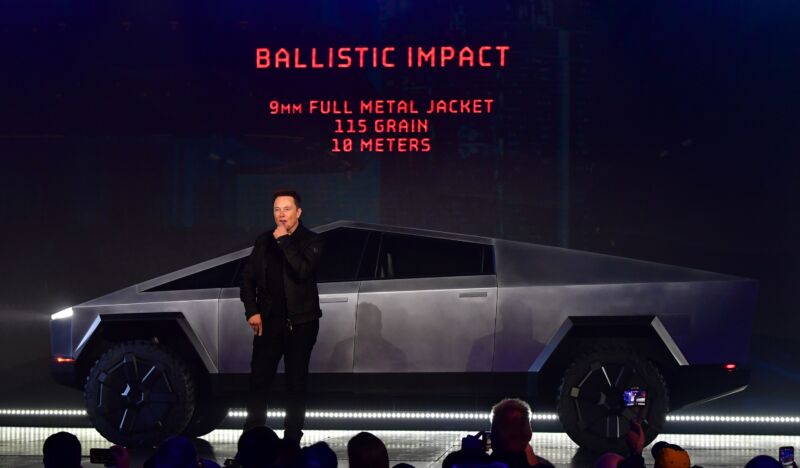
Tesla’s unconventional electric pickup is about to go into production, according to company CEO Elon Musk. As Ars noted yesterday, Tesla’s financial results for the third quarter of 2023 included the news that the company plans to begin deliveries of the Cybertruck at the end of November. But Musk also warned of probable complications ahead as his company tries to scale production.
The Cybertruck was first revealed during a chaotic presentation in 2019. It featured an exterior design that looked like it had been sketched with Mars in mind, made from unpainted stainless steel panels like the ill-fated DeLorean DMC12, and allegedly with bulletproof properties, all with a starting price of $39,900.
At the time, Musk promised Tesla would reinvent the most quintessentially American vehicle form factor. Instead of body-on-frame construction like the majority of trucks on our roads, or even a unibody construction like the Honda Ridgeline, the Cybertruck was originally going to feature a monocoque body, similar to a Formula 1 car or prototype, except made of folded stainless steel rather than carbon fiber.
Musk made much of this at the time, claiming that the body and bed of a conventional truck did nothing useful. “They are carried like cargo, like a sack of potatoes,” he said in 2019.
Exoskeletons are out, unibodies are in
Perhaps he regrets those words now; earlier this year, photos of under-construction Cybertrucks at the company’s factory in Austin, Texas, revealed stamped steel unibodies waiting to be clad in their unpainted stainless steel potato sacks body panels.
There have been plenty of other teething problems during the Cybertruck’s four-year gestation. Early trucks had unacceptable noise, vibration, and harshness levels, along with handling flaws and even “structural shake.”
In August, Musk was still concerned, sending an all-hands email to Tesla telling his workers that “[a]ll parts for this vehicle, whether internal or from suppliers, need to be designed and built to sub 10 micron accuracy. That means all part dimensions need to be to the third decimal place in millimeters and tolerances need to be specified in single digit microns. If LEGO and soda cans, which are very low cost, can do this, so can we.”
On yesterday’s call with investors, Musk said he wanted to “temper expectations” and said that Tesla “dug our own grave with the Cybertruck.”
Tesla’s presentation claims an annual production rate of 125,000 Cybertrucks, and on the call, Musk said he thought that the company could build 250,000 Cybertrucks annually in Texas, although not until 2025. “I do want to emphasize that there will be enormous challenges in reaching volume production with the Cybertruck and then making the Cybertruck cashflow positive—this is simply normal,” Musk said.
Indeed, Tesla has repeatedly gone through what Musk terms “production hell” when trying to scale production.
Do people actually want big electric pickup trucks?
Whether demand exists for that many Cybertrucks remains to be proven. Electric pickups from other brands are barely making a dent in America’s enormous appetite for big trucks, and debate currently rages among those who track these things. Are high sales prices and limited towing ranges turning off potential buyers? Or are production problems and therefore minimal supplies to blame?
Anecdotes are growing about unsold Ford F-150 Lightnings on dealer lots, and General Motors’ ongoing inability to make Ultium battery cells at anything approaching scale has kept the gargantuan Hummer EV’s deliveries at a relative trickle. Right now, Rivian appears to be the market leader—with 14,374 R1Ts delivered during the first three quarters of 2023, it beat Ford’s cheaper F-150 by more than 2,000 units.
As for the Tesla, unlike its other four models, the plus-sized Cybertruck has little appeal to drivers in Europe or China, and that promised sub-$40,000 price promise evaporated last year. Currently, the Tesla Cybertruck page has no pricing other than a $100 deposit and no way to configure a truck.
https://arstechnica.com/?p=1977179

